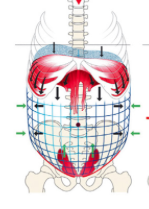
Bad Back? It Might Be The Way You Breathe
Breathing has another important function than just a way to get oxygen. It also plays a role of creating strength in your core and back. Right now, as you are reading this article, pay attention to your breathing. Are you breathing more in your abdomen or more in your chest? If you are unsure, place one hand on your stomach and the other hand on your chest. Which hand is moving more? If you are breathing more in your chest, you have a predisposing weakness that will make you more prone back pain as well as neck, hip or shoulder pain.

If you are a “chest breather,” your breathing is ABNORMAL because your diaphragm muscle is weak and not working properly. The diaphragm is a very important core muscle that is below your lungs and attaches to your lower ribs and spine.
In NORMAL breathing during the inhale, the diaphragm contracts and pushes down on the abdominal organs causing the abdominal wall to expand outward like a balloon filling up with air. If your diaphragm is working properly, your entire abdomen should be expanding out and in with every breath.
If you feel your chest moving more when you breathe, your diaphragm is weak and not contracting in the right direction. You are compensating for this weakness by using neck and shoulder muscles to lift your chest, which is a common source of neck and shoulder tightness and pain. Not only that, your abdomen is not “pressurizing” the way it should, which is making your core weak and more prone to lower back and hip pain.
If You Are a Chest Breather, Here is a Simple Exercise That Can Help:
Lay on the floor with your legs supported on a chair, ottoman, or couch so your hips and legs are bent 90 degrees and your knees are shoulder width apart.
Your lumbar spine (low back) should be as flat as possible and touching the floor (no arching).
Your chin should be slightly tucked.
Place one hand on your abdomen below your belly button and the other hand on your chest. Imagine your lungs are in your abdomen and when you take a breath in you are filling your abdomen up with air, just like a balloon. On the exhale, let the air naturally empty from your abdomen. Your abdominal hand should move up and down as you breathe. The chest hand should move very little or not at all. This may take a bit of concentration. If your chest is no longer moving, you can place both hands on your abdomen.
If you are unable to get your breathing into your abdomen, you can lay on your stomach and do crocodile breathing.
Crocodile Breathing: Lay on your stomach, rest your forehead on the back of your hands and begin breathing into your abdomen. After 20 or 30 breaths, turn onto your back again and try breathing as described above.
If you want a stronger core and back, make a daily routine of doing at least 100 breaths and you will be on your way to become an abdominal breather again.
There are several levels of advancement to this exercise to increase core strength. Contact us to learn these advanced exercises if you want to have a stronger core and body.
We help people with bad backs, abnormal breathing and core weakness every day. If you would like a complimentary assessment of your breathing and core strength and would like to learn simple exercises you can do at home to improve your breathing and core strength, contact us.


